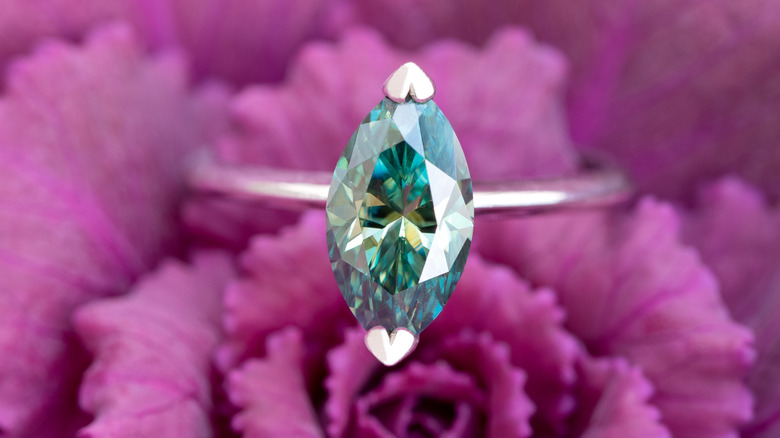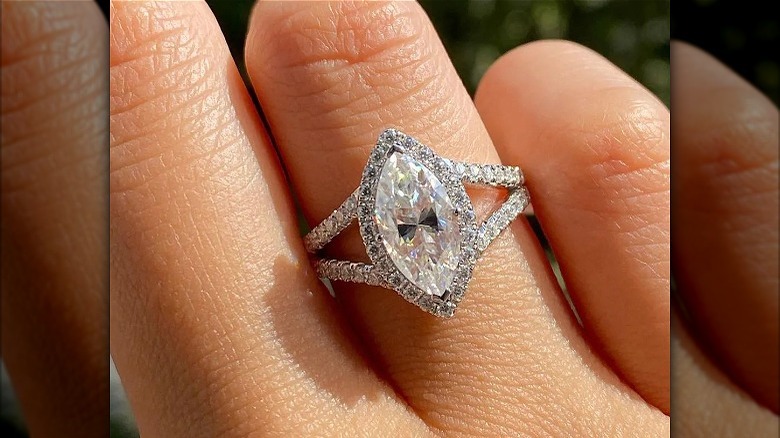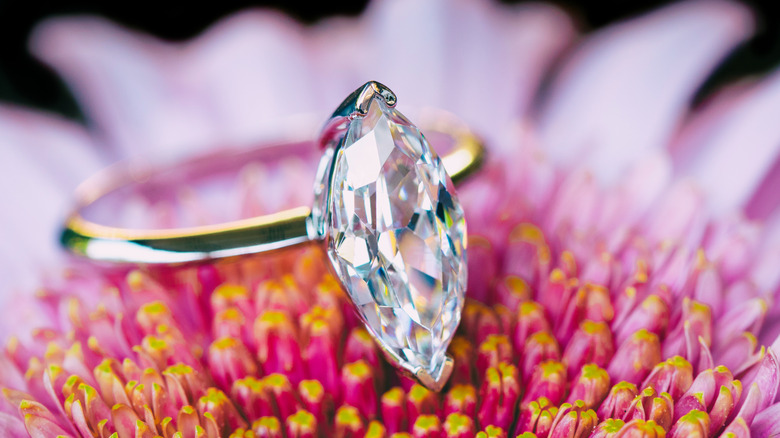Why You Should Think Twice About A Marquise Cut Engagement Ring (And What To Do If You're Set On It)
Rings have long been associated with marriage, with the first engagement bands signifying a contractual relationship in ancient Rome and Egypt, per Brides. However, diamond centerpieces are a relatively new concept, according to Vogue, first gaining mass popularity due to a mid-20th Century De Beers marketing campaign. Today, the vast majority of engagement rings — approximately 80%, according to a 2021 report by The Knot — have diamond inlays.
With this in mind, the human rights and environmental concerns associated with diamond mining have made lab-grown gems increasingly popular among the younger generations. Not only are lab-created gemstones more affordable than mined pieces, but they're also virtually indistinguishable.
Regarding the question of shape, round brilliant cut diamonds are the most common choice, expertly designed to reflect light at every possible angle (via Quality Diamonds). Still, oval shapes are steadily growing in popularity. Many of those hoping for a vintage-inspired, unique aesthetic opt for a marquise cut engagement ring. If you're thinking about investing in this style of diamond, it's important to first understand the risks.
Look out for the bow tie effect
Marquise cut diamonds are a trend 300 years in the making — their origins can be traced back to King Louis XV of France, who allegedly wanted a diamond cut in the shape of his mistress' mouth, per International Gem Society. Marquise diamonds have less depth than other shapes, meaning there's a lot more upward-facing surface area per carat weight. They appear larger than their rounded competitors and can give the ring finger a slim, extended look.
However, if you're hoping for a diamond that glistens at every angle, the marquise cut is sometimes lacking. Within the center of your diamond, you may notice a gray shadow that resembles a certain fashion accessory. This is aptly named the "bow tie effect" — light reflects off of the gem's facets to create a darkened center, a phenomenon that diminishes the diamond's overall value and luster. If you're set on a marquise cut ring, examine the stone from every angle and compare your options before taking out your wallet.
Moreover, the higher the carat count, the more likely you are to notice a yellowish tint near the tips of your marquise cut diamond. The less color a diamond has, the higher it's valued. When it comes to marquise cuts especially, always be on the lookout for unwanted hints of yellow. The average engagement ring costs upwards of $5,000, according to Credit Donkey — purchases this large should always be thoroughly researched.
Marquise cut engagement rings are easier to chip
The shallow, pointed ends of the marquise cut diamond make it particularly susceptible to chipping. Unfortunately, this type of damage can't be repaired. In order to prevent wear and tear from happening in the first place, it's important to protect the fragile ends of your diamond. As advised by the International Gem Society, prongs at each point of the stone in a V-shape will hold it in place and create a protective layer in the process. In general, your stone will be kept the most secure with six prongs or, ideally, a bezel setting (when the metal completely encases the diamond).
Whereas a north-south (aka, vertical) placement is most common for this type of diamond, celebrities like Portia de Rossi and Catherine Zeta-Jones are known for their horizontal diamonds (via With Clarity). Though this style won't have the same lengthening effect on your ring finger — one of the main draws of the marquise cut — the east-west placement will help protect your gem from unwanted chips. The bottom line? Although there are far more risks when it comes to these pointed diamonds, their vintage appeal will set your engagement ring apart from the round cuts dominating the market.


